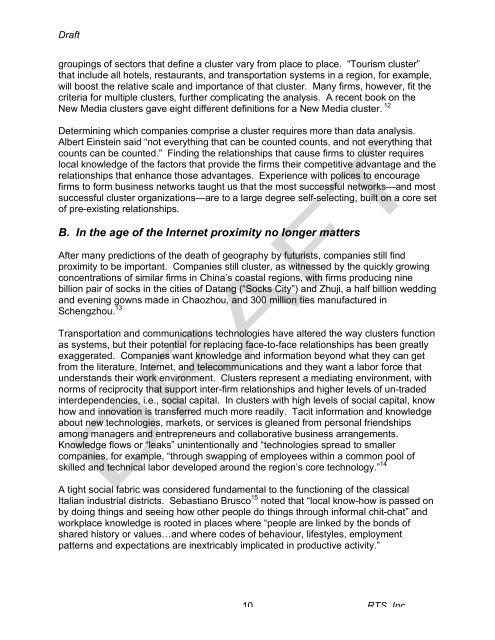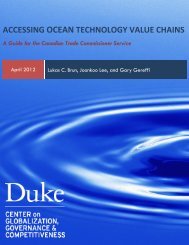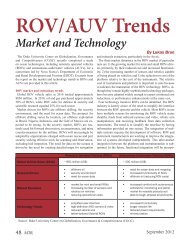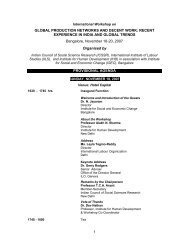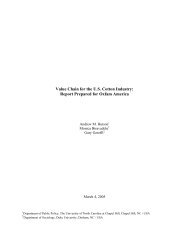Paper - Center on Globalization, Governance & Competitiveness
Paper - Center on Globalization, Governance & Competitiveness
Paper - Center on Globalization, Governance & Competitiveness
You also want an ePaper? Increase the reach of your titles
YUMPU automatically turns print PDFs into web optimized ePapers that Google loves.
Draft<br />
groupings of sectors that define a cluster vary from place to place. “Tourism cluster”<br />
that include all hotels, restaurants, and transportati<strong>on</strong> systems in a regi<strong>on</strong>, for example,<br />
will boost the relative scale and importance of that cluster. Many firms, however, fit the<br />
criteria for multiple clusters, further complicating the analysis. A recent book <strong>on</strong> the<br />
New Media clusters gave eight different definiti<strong>on</strong>s for a New Media cluster. 12<br />
Determining which companies comprise a cluster requires more than data analysis.<br />
Albert Einstein said “not everything that can be counted counts, and not everything that<br />
counts can be counted.” Finding the relati<strong>on</strong>ships that cause firms to cluster requires<br />
local knowledge of the factors that provide the firms their competitive advantage and the<br />
relati<strong>on</strong>ships that enhance those advantages. Experience with polices to encourage<br />
firms to form business networks taught us that the most successful networks—and most<br />
successful cluster organizati<strong>on</strong>s—are to a large degree self-selecting, built <strong>on</strong> a core set<br />
of pre-existing relati<strong>on</strong>ships.<br />
B. In the age of the Internet proximity no l<strong>on</strong>ger matters<br />
After many predicti<strong>on</strong>s of the death of geography by futurists, companies still find<br />
proximity to be important. Companies still cluster, as witnessed by the quickly growing<br />
c<strong>on</strong>centrati<strong>on</strong>s of similar firms in China’s coastal regi<strong>on</strong>s, with firms producing nine<br />
billi<strong>on</strong> pair of socks in the cities of Datang (“Socks City”) and Zhuji, a half billi<strong>on</strong> wedding<br />
and evening gowns made in Chaozhou, and 300 milli<strong>on</strong> ties manufactured in<br />
Schengzhou. 13<br />
Transportati<strong>on</strong> and communicati<strong>on</strong>s technologies have altered the way clusters functi<strong>on</strong><br />
as systems, but their potential for replacing face-to-face relati<strong>on</strong>ships has been greatly<br />
exaggerated. Companies want knowledge and informati<strong>on</strong> bey<strong>on</strong>d what they can get<br />
from the literature, Internet, and telecommunicati<strong>on</strong>s and they want a labor force that<br />
understands their work envir<strong>on</strong>ment. Clusters represent a mediating envir<strong>on</strong>ment, with<br />
norms of reciprocity that support inter-firm relati<strong>on</strong>ships and higher levels of un-traded<br />
interdependencies, i.e., social capital. In clusters with high levels of social capital, know<br />
how and innovati<strong>on</strong> is transferred much more readily. Tacit informati<strong>on</strong> and knowledge<br />
about new technologies, markets, or services is gleaned from pers<strong>on</strong>al friendships<br />
am<strong>on</strong>g managers and entrepreneurs and collaborative business arrangements.<br />
Knowledge flows or “leaks” unintenti<strong>on</strong>ally and “technologies spread to smaller<br />
companies, for example, “through swapping of employees within a comm<strong>on</strong> pool of<br />
skilled and technical labor developed around the regi<strong>on</strong>’s core technology.” 14<br />
A tight social fabric was c<strong>on</strong>sidered fundamental to the functi<strong>on</strong>ing of the classical<br />
Italian industrial districts. Sebastiano Brusco 15 noted that “local know-how is passed <strong>on</strong><br />
by doing things and seeing how other people do things through informal chit-chat” and<br />
workplace knowledge is rooted in places where “people are linked by the b<strong>on</strong>ds of<br />
shared history or values…and where codes of behaviour, lifestyles, employment<br />
patterns and expectati<strong>on</strong>s are inextricably implicated in productive activity.”<br />
10<br />
RTS, Inc.


